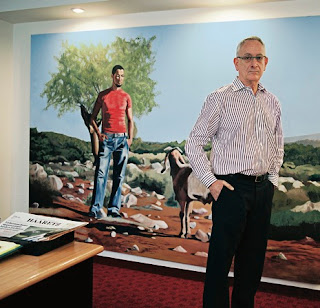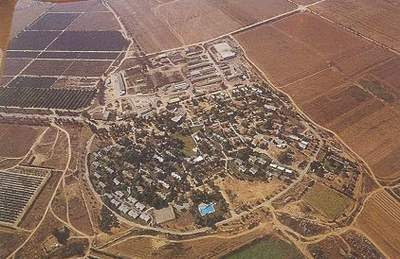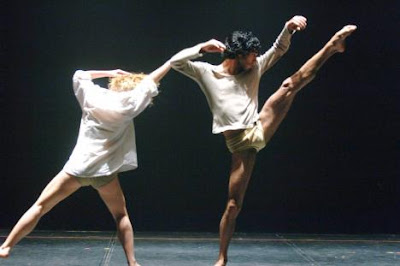At that time, I had finished my study at university and I became a teacher in high school. The first thing to make it, I brought my pupils, the Palestinian pupils, here to Wahat Al-Salam/Neve Shalom. My Jewish colleague, he’s a teacher of Jewish school, he brought his pupils here—and they start meet here. And the only motivation is a good will. No experience. No profession. Nothing. What to do with them, we don’t know. Okay, let’s talk. Let’s dance. Let’s pray together. In this way. And sometimes, this day was so calm; pupils went home and we summarized it: it was a successful day. Sometimes, pupils they entered into hot discussions and shouting and a lot of anger coming out, and we summarized: it was a failure day. Until some people from outside the community—I think they were there from the academy—came to see the new thing that is happening here, encounters and all of these things.
And there was nothing sort of else like it in Israel or Palestine?
No, there was not a lot of things like this. We were the first to create this kind of thing. And the first thing I—the most—I still remember up to today is that [we asked] how do you decide if it was a failure and how it was a success? Upon what criteria? Let’s put question mark on it—we’re not sure. And then it shook our confidence, this kind of intervention. It was not easy for me to accept it. But, the reality is stronger than my feelings and then—then after some years, we decide to have a very serious academic research about this kind of activities. We get help to invite and research institution from outside of the community, and we ask from them a program of research, and they give us five years intervention and research and it’s the step that crystallized the work of Wahat Al-Salam/Neve Shalom, the School for Peace, until today. Of course one of the concepts that, that there is no one reality; there is no real results; everything is in (pause) changing as reality change, and the work should be changed here.
And how did it exactly crystallize? It was just a new way of thinking about it or?
No. They started with us as we are. Okay, what are your plans? What you are planning to achieve? Okay, this is what you want to achieve. Let’s make a questionnaire upon these things and give it to the participants. We choose a test group that they are not participating in the workshop and let’s see the change of the ideas of the participants.
So like a control group and a test group.
And the first year, black was in our eyes. That our activities, results, it was the total opposite of our aims. The participants, they gained more hatred, more prejudices before related to the other groups.
Really?
And the difference was, the other [non-workshop] groups, all their attention to the other side, they were assuming. Our group [in the workshops], they were sure. We needed to change all our attitudes.
What did you feel when you got those results at first?
Well, first of all, we were shocked. And then the research group, they said, let’s analyze it. …. Maybe our methodology, our approach, is not good; we need to change our methodology. Because we did at that time, it was belonged to the theory called the “contact theory”. The contact theory assumed that if you have two groups, different groups, and bring them together for a short period, the attitude of the participants toward the other group will be less prejudice and less enmity.
Okay. And just by being in contact?
Yes, by being in contact. And there were a lot of researches done all over the world and they found it positively. Why here it’s the negative—the opposite. And then they said, maybe the reality here between Arabs and Jews is not the same like the reality between Americans and Chinese or between French and British or between other things.
Or French and English Canadians.
Yeah, something like that. Then we need to have a different approach. We said, okay, why we just feel the need to do it? Because we have a conflict. Does the conflict have any role inside the encounter? Yes or no. In the contact theory, no. Then we need to bring the conflict inside the group. “We don’t need to bring it,” they said. Maybe the facilitation is preventing the conflict from getting inside. And it’s right. Because other time we were using things like, “Let’s listen one to the other side. Let’s be patient one to the other side. We don’t want to—let’s calm the situation.” All these have a meaning as a message: don’t bring conflict inside. And then the participants, they didn’t bring conflict inside.
Then we said, let’s try, okay, if somebody will talk about his or her fear, about her anger, about her prejudice—come in, and take it as a material. And give it a place and, of course, we changed our analyses and our concentration from the interpersonal relation to the intergroup relation. Because, really, the individuals when they are coming as individuals, one of their aims is to have a personal relation. But the conflict is not there. The conflict is somewhere else in the intergroup relation. And, if we are not touching this level, we can’t understand the conflictual dynamics. And we start working in this thing. And created a lot of difficulties for the schools, for the participants themselves, and sometimes, for mainly the Jewish participants that one of their aims to participate in the workshop is to stay on the human level of the interpersonal relation. The facilitation help us how to see the diversity of the motivation of the two groups.
And what were the differences?
The differences…one of the things that we realized that when hot discussions started, they—the Jewish participants—they make their efforts to calm the situation: “We didn’t come here to fight; please, be quiet.” All of these things. “I understand your anger, but, the reality is not like that.” Means give [acknowledgement] to the individual of their anger, but not to the reality of it. Or to exclude a negative experience of one person from the reality. The Arab, the Palestinian participants— they didn’t go to this direction. When one Palestinian participant broke his anger, and all they joined his anger: yes, it’s ours—like this. They didn’t cooperate with the Jews more for having the human aspect or the participating or calming the situation. They started: “no we are not coming here to speak about personal relations; we are coming here to speak about our rights. We are going, we are ready to speak about equality.”
So as a facilitator, how do you moderate those kind of differences? To bring people to be aware what is going on?
Okay, so you just make them aware of those differences.
Yeah. For example, we think participants, they are not aware what is going on. Even very simple things, when they are sitting together and discussing, the first thing is happening just in the first minute when we come inside the room together, you will find that half of the circle, they are Jews, and half the circle, they are Arabs. Just to give a photo. It seems that it’s still—we are not so confident. Are all Jews in one side and all Arabs on other side? We don’t know what it means, but it exists. As the facilitators, we learn that we are not allowed to make it more than it is. Just this is—maybe for some, it has a meaning; for others, it’s just that.


